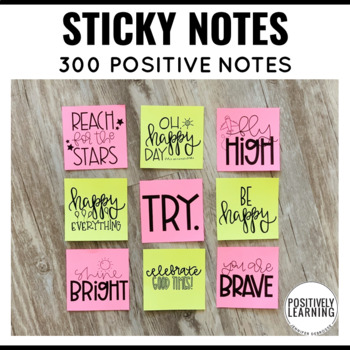

Once students understand what acts of kindness are, introduce them to the idea of random acts of kindness. Once the students are done, collect the notecards and read them aloud in order to help the students understand acts of kindness. You can also have students brainstorm independently by passing out a notecard to each child and instructing the students to write down something nice that someone else did for them lately and how it made them feel.

small), but be sure to emphasize the importance of small acts of kindness in addition to grand gestures. You can brainstorm as a large group with open-ended questions like, “What was something kind you saw someone do lately-big or small?” Write down the students’ responses on a whiteboard or chalkboard and break them into two categories (big vs.
#Positive sticky notes how to#
With this concept in mind, brainstorming ideas on how to be kind as a class should instill a sense of ownership in kids that helps them feel excited about practicing kindness. There are many strategies for teaching kindness-far too many to include them all here-but below are six solid strategies to start with (Proud to be Primary, 2017).īrainstorm ideas as a class (or a family)Ĭhildren (and adults) are more likely to be engaged and involved in something they helped create or develop (Dirks, Cummings, & Pierce, 1996). Kindness can be taught at home or in the classroom, and preferably, it’s taught in both contexts. However, it is something that should be practiced regularly to ensure that it will stick with kids throughout childhood and into adulthood. The good news is that kindness is a natural human response that likely won’t need much prodding or encouragement. This likely sounds like a very daunting task. How do you teach something as important as kindness to children? Other Fun Empathy Exercises for the Classroom.3 Empathy Worksheets for Students & Adults (PDFs).How to Teach Empathy to Children & Adults.7 Kindness Activities for Elementary Students, Preschoolers, and Middle Schoolers.These science-based exercises will not only enhance your ability to understand and work with your emotions but will also give you the tools to foster the emotional intelligence of your clients, students or employees.
#Positive sticky notes download#
Before you read on, we thought you might like to download our three Emotional Intelligence Exercises for free. Kindness and empathy are important in fostering emotional intelligence. To this end, this article will walk you through a range of fun activities, exercises, and worksheets to help both children and adults develop the capacity for kindness and empathy in everyday life. Likewise, imagine how different classrooms, offices, organizations, and homes around the world might be if more adults stopped to consider how they might demonstrate more empathy and kindness in their regular interactions.

While many of a child’s everyday activities, such as playing, going to school, and interacting with caregivers, will provide natural opportunities to develop these critical traits, there is plenty we can do to proactively develop a child’s kindness and empathy. If you were to ask a child psychologist which character traits are most important for a child’s development, kindness and empathy would likely rank high on the list.


 0 kommentar(er)
0 kommentar(er)
